Strut-and-Tie Model and Numerical Simulation of Sleeve Grouting Connection for Concrete-Filled Steel Tube Column
Abstract
1. Introduction
2. Strut-and-Tie Model
2.1. Strut-and-Tie Model Based on ACI Code
2.1.1. Nominal Bearing Force of the Strut
2.1.2. Nominal Bearing Force of Tie
2.1.3. Nominal Bearing Force of Node
2.2. Strut-and-Tie Model Based on EC2 Code
2.2.1. Strength of the Strut
2.2.2. Bearing Force of Node
3. The Example Analysis
3.1. Calculation of 60a Based on ACI Code
3.1.1. Strut Calculation of 60a Based on ACI Code
3.1.2. Node Calculation of 60a Based on ACI Code
3.2. Calculation of B3 Based on ACI Code
3.2.1. Strut Calculation of B3 Based on ACI Code
3.2.2. Node Calculation of B3 Based on ACI Code
3.3. Calculation of 60a Based on EC2 Code
3.3.1. Strut Calculation of 60a Based on EC2 Code
3.3.2. Node Calculation of 60a Based on EC2 Code
3.4. Calculation of B3 Based on EC2 Code
3.4.1. Strut Calculation of B3 Based on the EC2 Code
3.4.2. Node Calculation of B3 Based on EC2 Code
4. Numerical Analyses
4.1. Selection of Finite Element Model Parameters
4.2. Establishment of the Finite Element Model
4.2.1. Establishment of Specimen 60a Model
4.2.2. Establishment of Specimen B3 Model
4.3. Parameter Analysis
4.3.1. Shear Key Height
4.3.2. Shear Key Shape
4.3.3. Strength of Grouting Material
4.3.4. Shear Key Distance
5. Conclusions
- (1)
- The calculated values of the strut-and-tie model based on the ACI code and EC2 code were close to the experimental values, among which the average ratio of the calculated-to-experimental values based on the ACI code was 1.07, and the average ratio of the calculated-to-experimental values based on the EC2 code was 1.09. This shows that the strut-and-tie model is applicable to the sleeve grouting connection of CFST columns.
- (2)
- High-precision finite element models of the sleeve grouting connection were established, and the existence of the struts in the sleeve grouting connection of the CFST column was further verified by the strain of the grouting material in the finite element model.
- (3)
- An increase in the shear key height can improve the axial compression capacity and ductility of the sleeve grouting connection. The suggested height range of the shear key is 2 to 3 mm, the model mechanics performance was better. When the shear key height was less than 2 mm, the axial compression capacity of the model was low, so that height was not recommended for use. When the shear key height was more than 3 mm, the axial compression capacity and ductility performance were not significantly increased.
- (4)
- It is suggested to adopt the shape of semicircular, rectangular vertical and trapezoidal shear keys, which can meet the requirements of sleeve grouting connections of CFST columns and have good mechanical performance. The rectangular vertical shear key showed the best load transmission performance, and the stress was not concentrated in the sleeve grouting connection, the rectangular transverse shear key showed the worst load transmission and were not recommended.
- (5)
- When the grouting material strength was C80 and C90, the axial compression capacity of the finite element model was better. With the increase in strength of the grouting material, the axial compression capacity of the sleeve grouting connection also increased, and the model showed the best deformation capacity when the grouting material strength was C90. It is reasonable to use grouting material strengths C50 to C90 for the sleeve grouting connection.
- (6)
- When the shear key distance is 50 mm, compared with the shear key distance of 45 mm, the bearing capacity was reduced by 31.2% and the displacement corresponding to the bearing capacity decreased by 47.0%, it showed that the axial compression capacity and deformation performance were significantly reduced, height-distance ratio less than 0.044 was not recommended. When the height-distance ratio is 0.044 to 0.1, the model performance of the sleeve grouting connection is close, and there is a higher axial compression capacity and deformation capacity, it is a reasonable height-distance ratio range.
Author Contributions
Funding
Institutional Review Board Statement
Informed Consent Statement
Data Availability Statement
Acknowledgments
Conflicts of Interest
References
- Han, L.H.; Wang, Z.B.; Xu, W.; Tao, Z. Behavior of concrete-encased CFST members under axial tension. J. Struct. Eng. 2016, 142, 1–12. [Google Scholar] [CrossRef]
- Wang, J.F.; Cai, A.M.; Liu, J. Analysis of offshore wind turbine foundation in China. In Proceedings of the 12th Annual Meeting of China Association for Science and Technology, Fuzhou, China, 1–13 November 2010; pp. 1–7. [Google Scholar]
- Liu, Y.; Guo, Z.X.; Jia, L.P.; Chen, Q.M. Experimental study on axial compression performance and design method of core steel tube reinforced concrete short columns. J. Build. Struct. 2015, 36, 135–142. [Google Scholar] [CrossRef]
- Liu, Y.; Wang, C.; Guo, Z.X.; Wang, P.Z.; Xu, Y.P. Axial compression performance and load bearing mechanism of prefabricated core steel tube reinforced concrete columns. J. Cent. S. Univ. (Sci. Technol.) 2019, 50, 3127–3136. [Google Scholar] [CrossRef]
- Chen, J.W.; Yan, W.S.; Su, Y.P.; Chen, H.B.; Feng, X.M. Experimental study on seismic performance of prefabricated shear wall with concrete filled steel tube. J. Build. Struct. 2015, 36, 176–184. [Google Scholar] [CrossRef]
- Chen, J.W.; Su, Y.P.; Gong, L.Y.; Yan, W.S.; Chen, H.B. Experimental study on seismic performance of prefabricated shear wall with concrete filled steel tube and opening. J. Build. Struct. 2016, 37, 251–260. [Google Scholar] [CrossRef]
- Nilson, H. Arthur, D. David, W.D. Charles. Design of Concrete Structures; McGraw-Hill Higher Education: New York, NY, USA, 2009; p. 332. [Google Scholar]
- Wu, L.W.; Su, Y.P.; Chen, H.B.; Yu, H.; Li, Y.P. Experimental study on axial mechanical performance of steel pipe-to-sleeve grouted connection. J. Build. Struct. 2019, 40, 191–199. [Google Scholar] [CrossRef]
- Wight, J.K.; MacGregor, J.G. Reinforced concrete: Mechanics and design. In Upper Saddle River; Pearson Education: New York, NY, USA, 2012; p. 879. [Google Scholar]
- Schlaich, J.; Schäfer, K.; Jennewein, M. Toward a consistent design of structural concrete. PCI J. 1987, 32, 74–150. [Google Scholar] [CrossRef]
- Schlaich, J.; Schäfer, K. Design and detailing of structural concrete using strut-and-tie models. Struct. Eng. 1991, 69, 113–125. [Google Scholar]
- Marti, P. Basic Tools of Reinforced Concrete Beam Design. ACI Struct. J. 1985, 82, 46–56. [Google Scholar] [CrossRef]
- Julio, A.; Ramirez, J.A. Strut-Tie Design of Pretensioned Concrete Members. ACI Struct. J. 1994, 94, 572–578. [Google Scholar] [CrossRef]
- ACI Committee 318. Building Code Requirements for Structural Concrete (ACI 318-14) and Commentary (318R-14); American Concrete Institute: Farmington Hills, MI, USA, 2014. [Google Scholar]
- European Committee for Standardization. Euro-Code 2, Design of Concrete Structures, Part 1-1: General Rules and Rules for Buildings, CEN, EN 1992-1-1; European Committee for Standardization: Brussels, Belgium, 2004. [Google Scholar]
- Adebar, P.; Zhou, Z. Bearing Strength of Compressive Struts Confined by Plain Concrete. ACI Struct. J. 1993, 90, 534–541. [Google Scholar] [CrossRef]
- Leu, L.J.; Huang, C.W.; Chen, C.S.; Asce, M.; Liao, Y.P. Strut-and-Tie design methodology for three-dimensional reinforced concrete structures. J. Struct. Eng. 2006, 132, 929–938. [Google Scholar] [CrossRef][Green Version]
- Yun, Y.M.; Kim, B.H. Two-dimensional grid Strut -Tie model approach for structural concrete. J. Struct. Eng. 2008, 134, 1199–1214. [Google Scholar] [CrossRef]
- Wilson, H.R.; Yousefpour, H.; Brown, M.D.; Bayrak, O. Investigation of corbels designed according to strut-and-tie and empirical methods. ACI Struct. J. 2018, 115, 813–824. [Google Scholar] [CrossRef]
- Adebar, P.; Kuchma, D.; Collins, M.P. Strut-and-tie models for the design of pile caps: An experimental study. ACI Struct. J. 1990, 87, 81–92. [Google Scholar] [CrossRef]
- Adebar, P.; Zhou, L. Design of deep pile caps by strut-and-tie models. ACI Struct. J. 1996, 93, 437–448. [Google Scholar] [CrossRef]
- Guo, H.L. Investigation on Punching Behavior of Pile Cap under Column Reinforced by Section Steel Truss. ACI Struct. J. 2018, 115, 379–390. [Google Scholar] [CrossRef]
- Broms, C.E. Strut-and-Tie Model for Punching Failure of Column Footings and Pile Caps. ACI Struct. J. 2018, 115, 689–698. [Google Scholar] [CrossRef]
- Meléndez, C.; Sagaseta, J.; Sosa, P.M.; Rubio, L.P. Refined Three-Dimensional Strut-and-Tie Model for Analysis and Design of Four-Pile Caps. ACI Struct. J. 2019, 116, 15–29. [Google Scholar] [CrossRef]
- Matamoros, A.B.; Wong, K. Design of simply supported deep beams using strut and tie models. ACI Struct. J. 2003, 100, 704–712. [Google Scholar] [CrossRef]
- Brown, M.D.; Bayrak, O. Design of deep beams using strut-and-tie models—Part I: Evaluating US provisions. ACI Struct. J. 2008, 105, 395–404. [Google Scholar] [CrossRef]
- Brown, M.D.; Bayrak, O. Design of deep beams using strut-and-tie models—Part II: Design recommendations. ACI Struct. J. 2008, 105, 405–413. [Google Scholar] [CrossRef]
- Russo, G.; Venir, R.; Pauletta, M. Reinforced concrete deep beams-shear strength model and design formula. ACI Struct. J. 2005, 102, 429–437. [Google Scholar] [CrossRef]
- Hwang, S.J.; Lu, W.Y.; Lee, H.J. Shear strength prediction for deep beams. ACI Struct. J. 2000, 97, 367–376. [Google Scholar] [CrossRef]
- Yang, K.H.; Ashour, A.F. Strut-and-tie model based on crack band theory for deep beams. J. Struct. Eng. 2011, 137, 1030–1038. [Google Scholar] [CrossRef]
- Rezaei, N.; Klein, G.; Garber, D.B. Effect of Development and Geometry on Behavior of Concrete Deep Beams. ACI Struct. J. 2019, 116, 171–181. [Google Scholar] [CrossRef]
- Tuchscherer, R.G.; Birrcher, D.B.; Bayrak, O. Reducing Discrepancy between Deep Beam and Sectional Shear-Strength Predictions. ACI Struct. J. 2016, 113, 3–16. [Google Scholar] [CrossRef]
- Hwang, S.J.; Lee, H.J. Analytical model for predicting shear strengths of exterior reinforced concrete beam-column joints for seismic resistance. ACI Struct. J. 1999, 96, 846–857. [Google Scholar] [CrossRef]
- Hwang, S.J.; Lee, H.J. Analytical model for predicting shear strengths of interior reinforced concrete beam-column joints for seismic resistance. ACI Struct. J. 2000, 97, 35–44. [Google Scholar] [CrossRef]
- Wu, L.W. Experimental Study on Sleeve Grouted Connection Performance of Mine Concrete Filled Steel Tube; North China University of Science and Technology: Tangshan, China, 2018. [Google Scholar]
- Smith, B.L.; Tebbett, I.E. New Data on Grouted Connections with Large Grout Dimensions; Society of Petroleum Engineers: Houston, TX, USA, 1989; pp. 291–298. [Google Scholar] [CrossRef]
- Wang, G.Q. The Axial Bearing Capacity of Large-Diameter Grouted Connections for Offshore Wind Turbines; Zhejiang University: Hangzhou, China, 2017. [Google Scholar]
- Gong, J.X.; Wei, W.W.; Hu, J.H. China, American and European Concrete Structure Design; China Building Industry Press: Beijing, China, 2003. [Google Scholar]
- Yu, Z.W.; Ding, F.X. Unified calculation method of compressive mechanical properties of concrete. J. Build. Struct. 2003, 24, 41–46. [Google Scholar]
- Ding, F.X.; Yu, Z.W. Unified calculation method of tensile mechanical properties of concrete. J. HUST 2004, 21, 29–34. [Google Scholar]
- Merxhani, A.; Jensen, J.F.; Caetano, J.; Christiansen, C.K. Critical review of early age cycling effects on the capacity of pile to sleeve grouted conncetions as treated in ISO 19902. In Proceedings of the ASME 2019 38th International Conference on Ocean, Offshore and Arctic Engineering OMAE2019, Glasgow, UK, 9–14 June 2019. [Google Scholar]
- Teng, L.R. Research of Grouted Connection to Improve the Axial Bearing Capacity in Offshore Wind; Da Lian University of Technology: Dalian, China, 2014. [Google Scholar]
- Lamport, W.B.; Jirsa, J.O.; Yura, J.O. Strength and behavior of grouted pile-sleeve conncetions. J. Struct. Eng. 1991, 117, 2477–2498. [Google Scholar] [CrossRef]
- Wang, Z.; Jiang, S.C.; Zhang, J. Structural performance of prestressed grouted pile-to-sleeve connection. Prog. Steel Build. Struct. 2010, 12, 11–18. [Google Scholar] [CrossRef][Green Version]
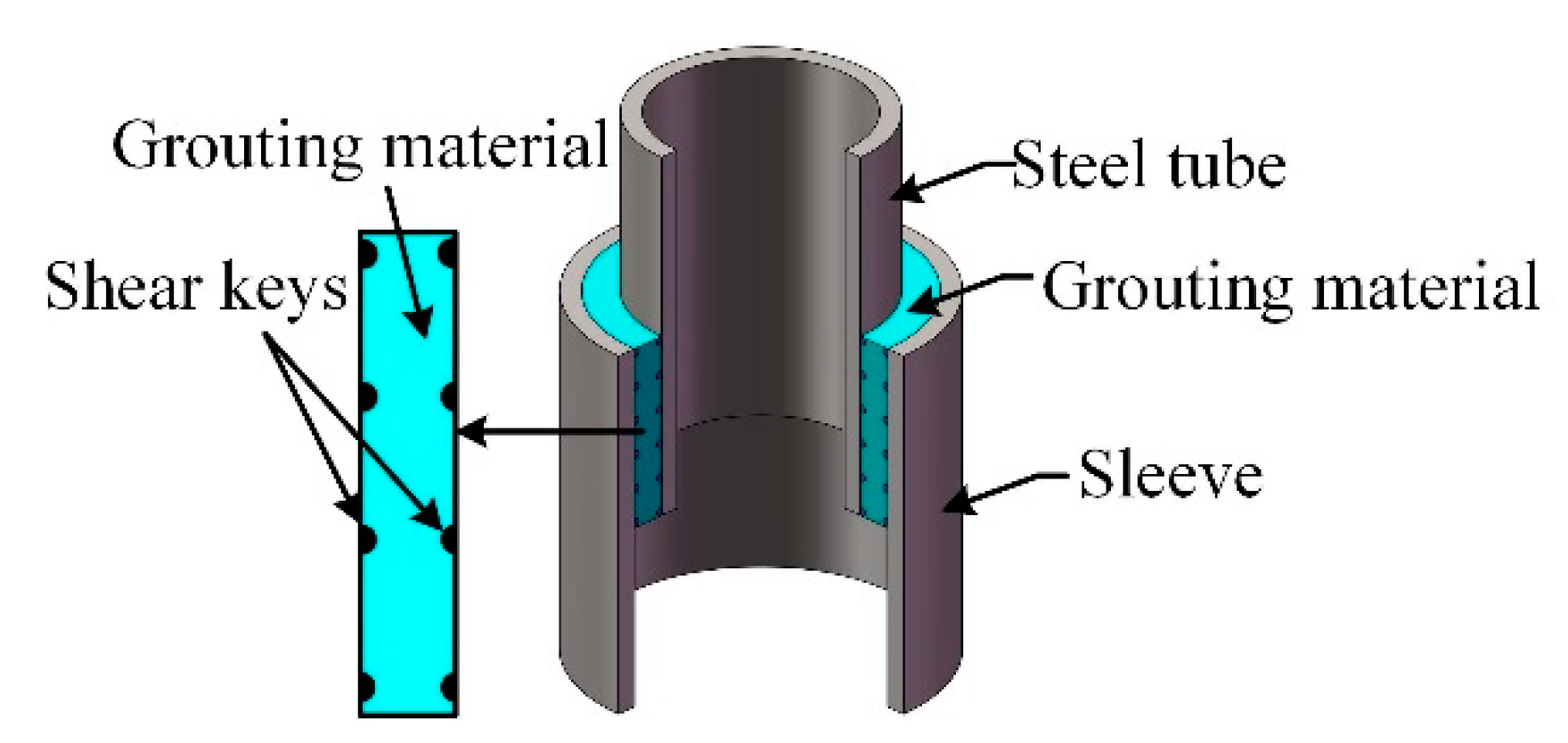

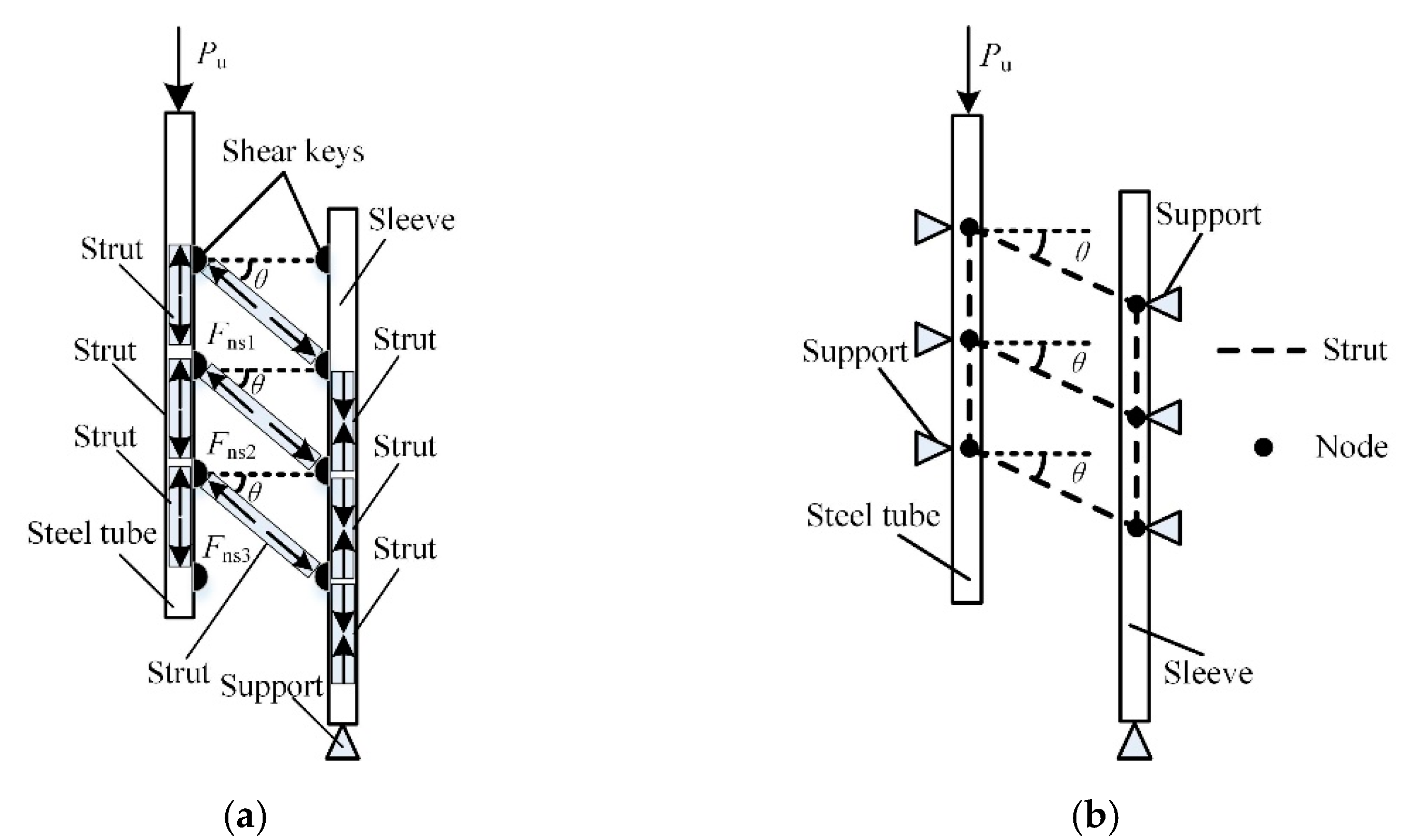
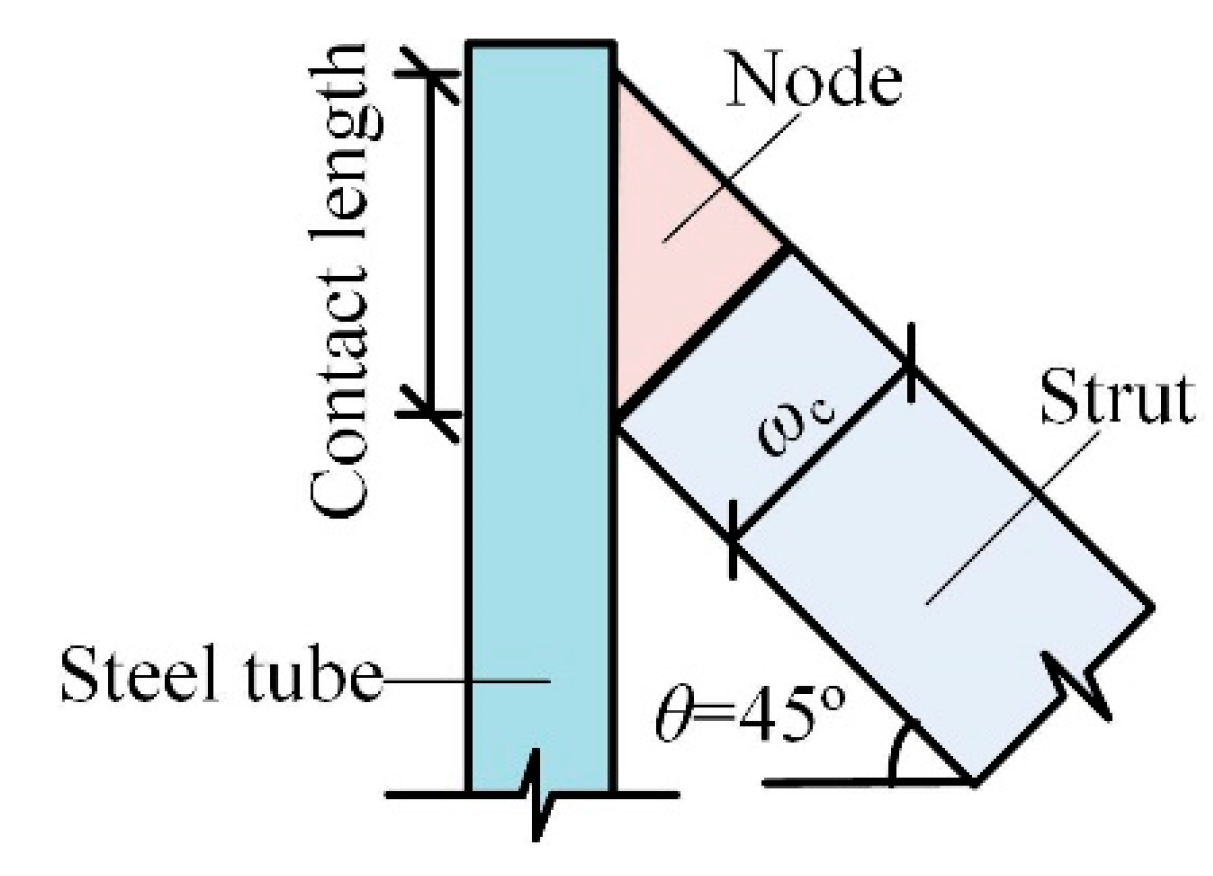
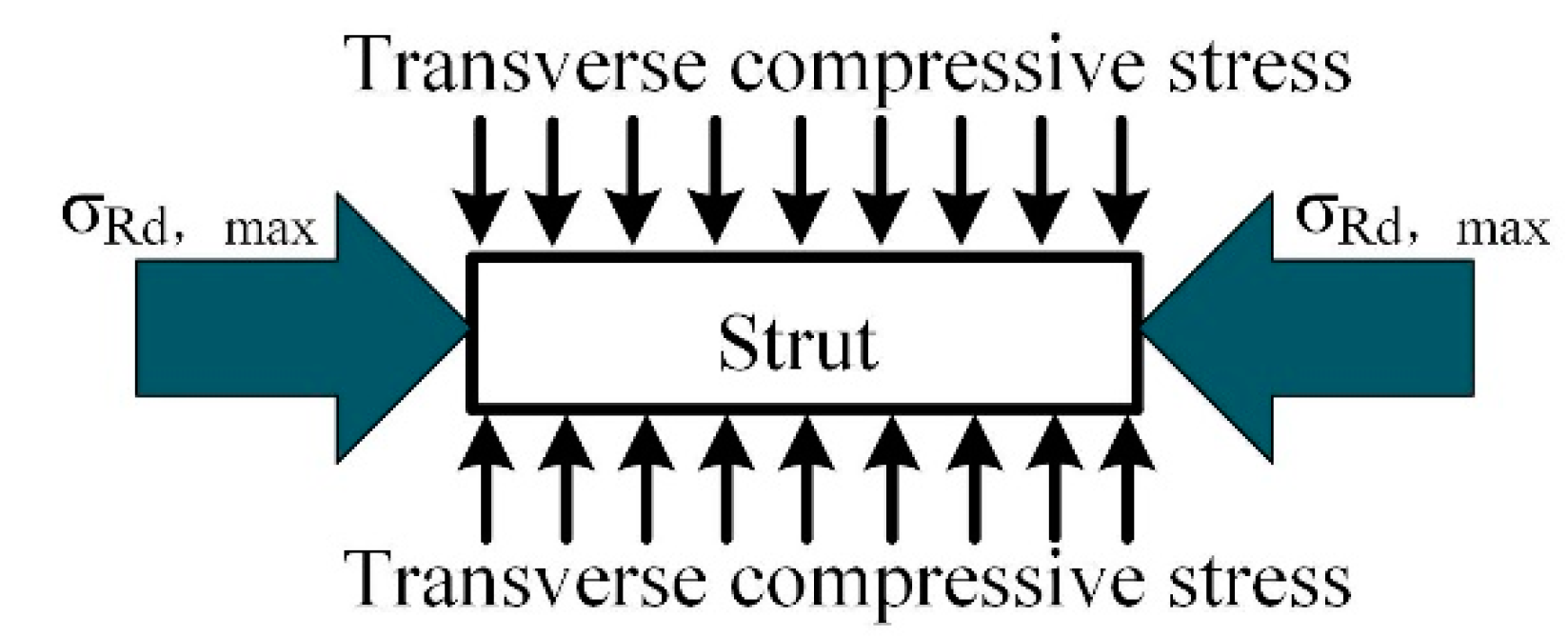
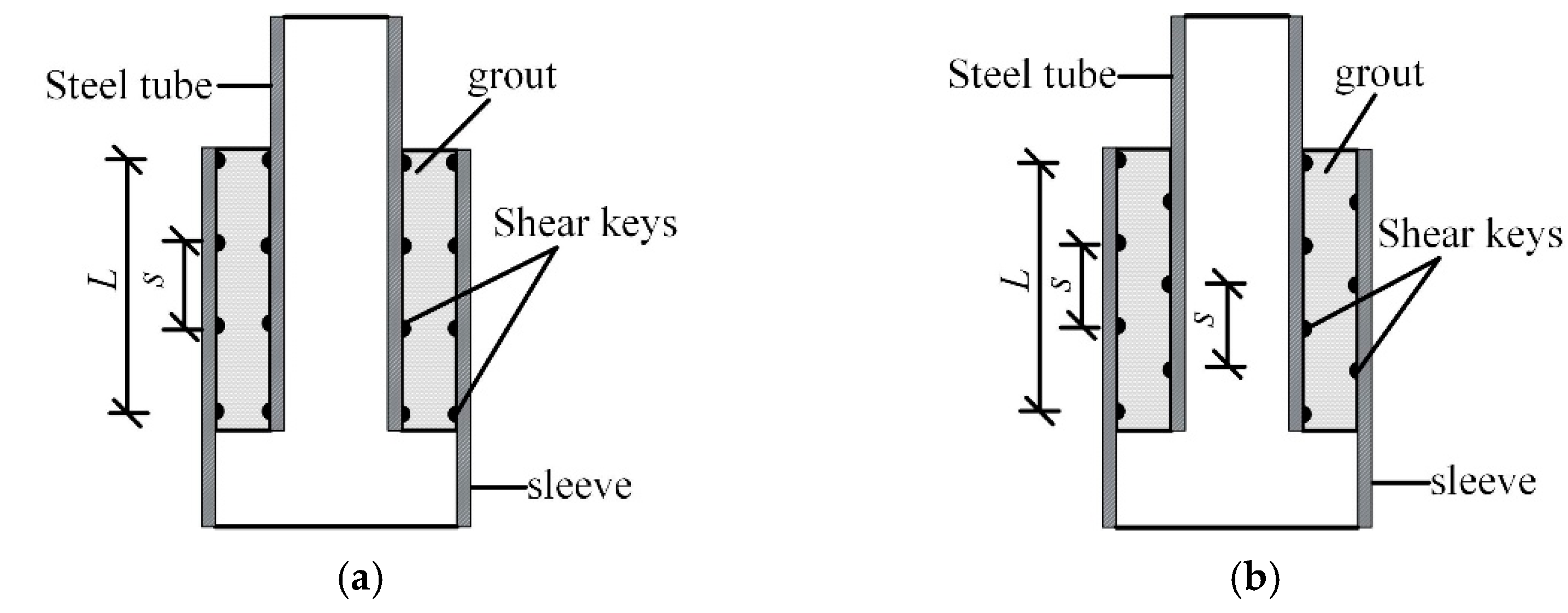
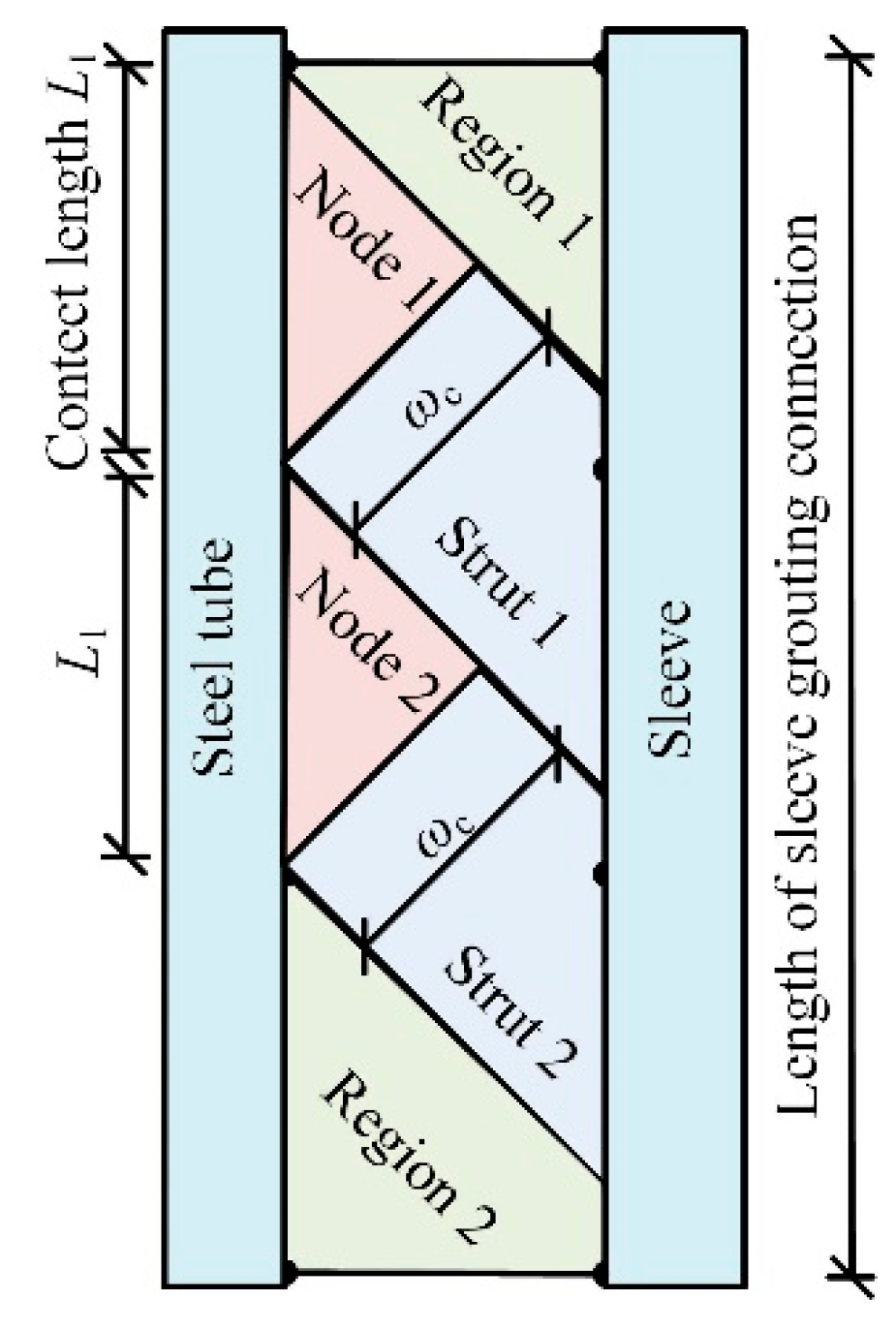

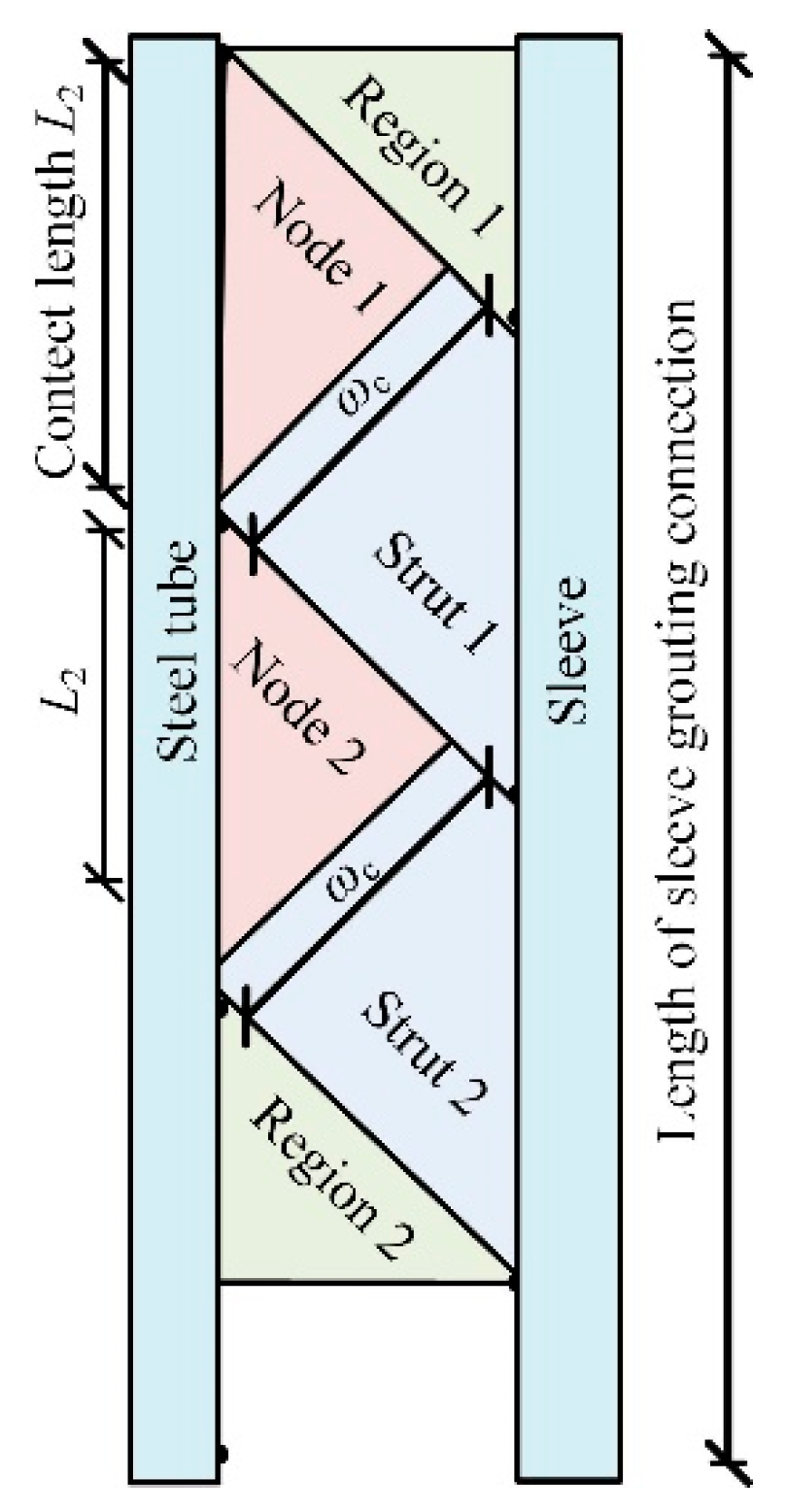
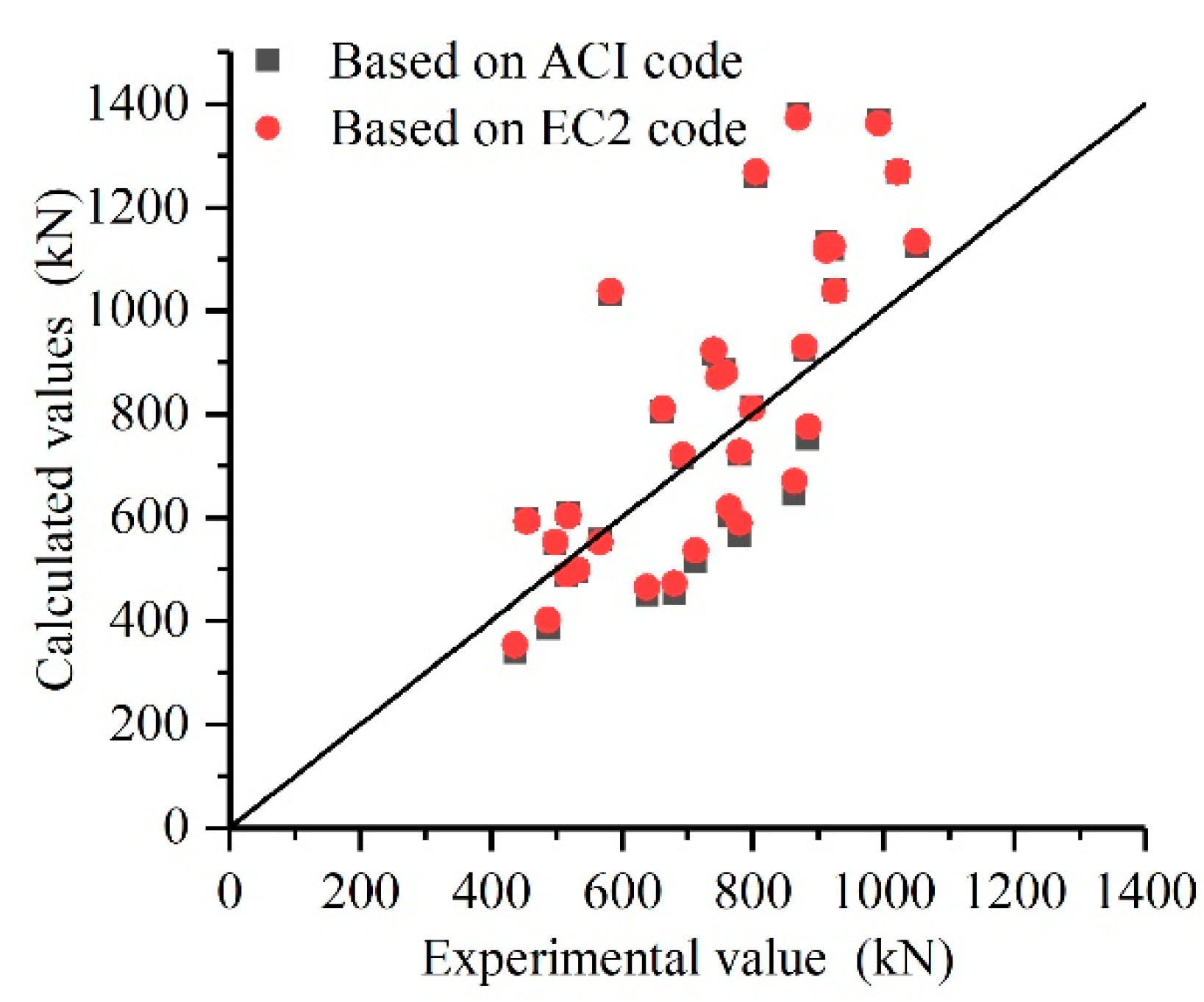

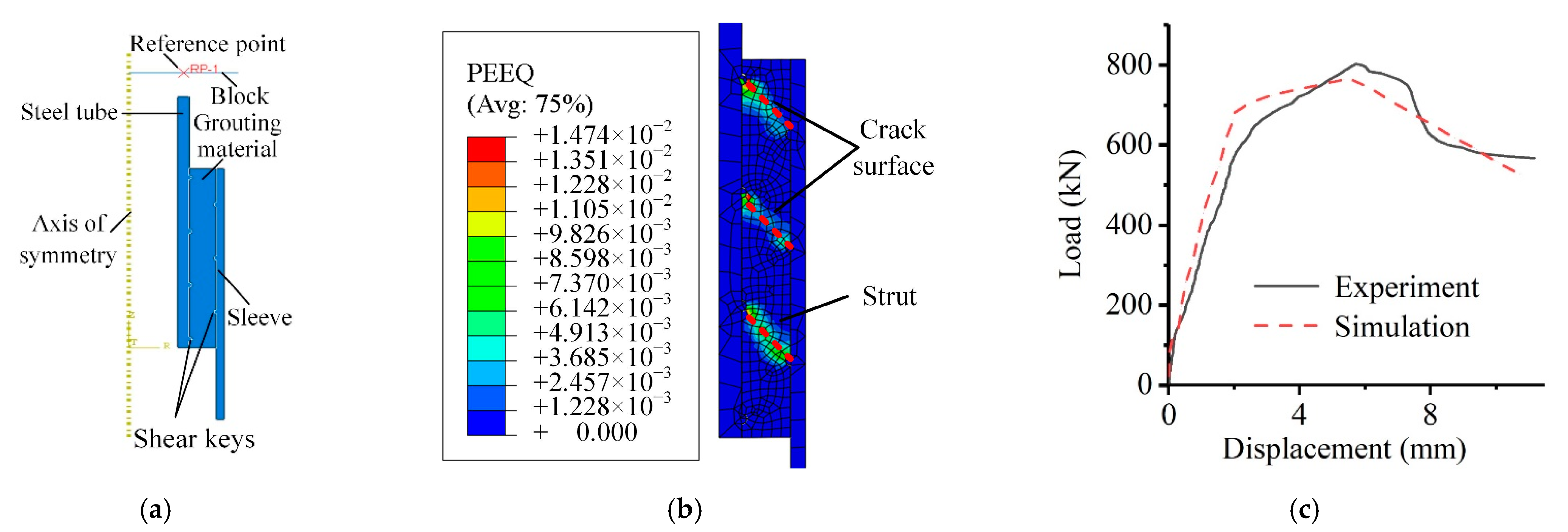

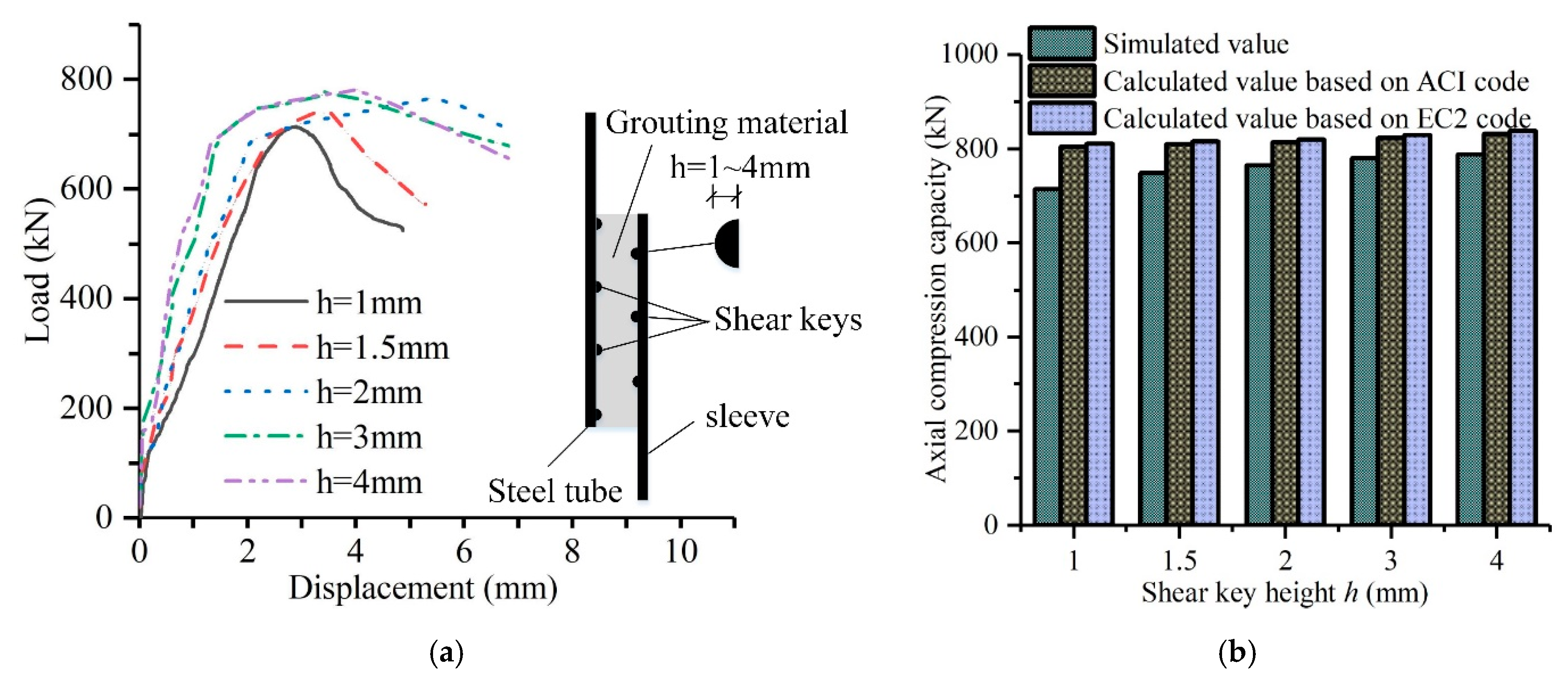
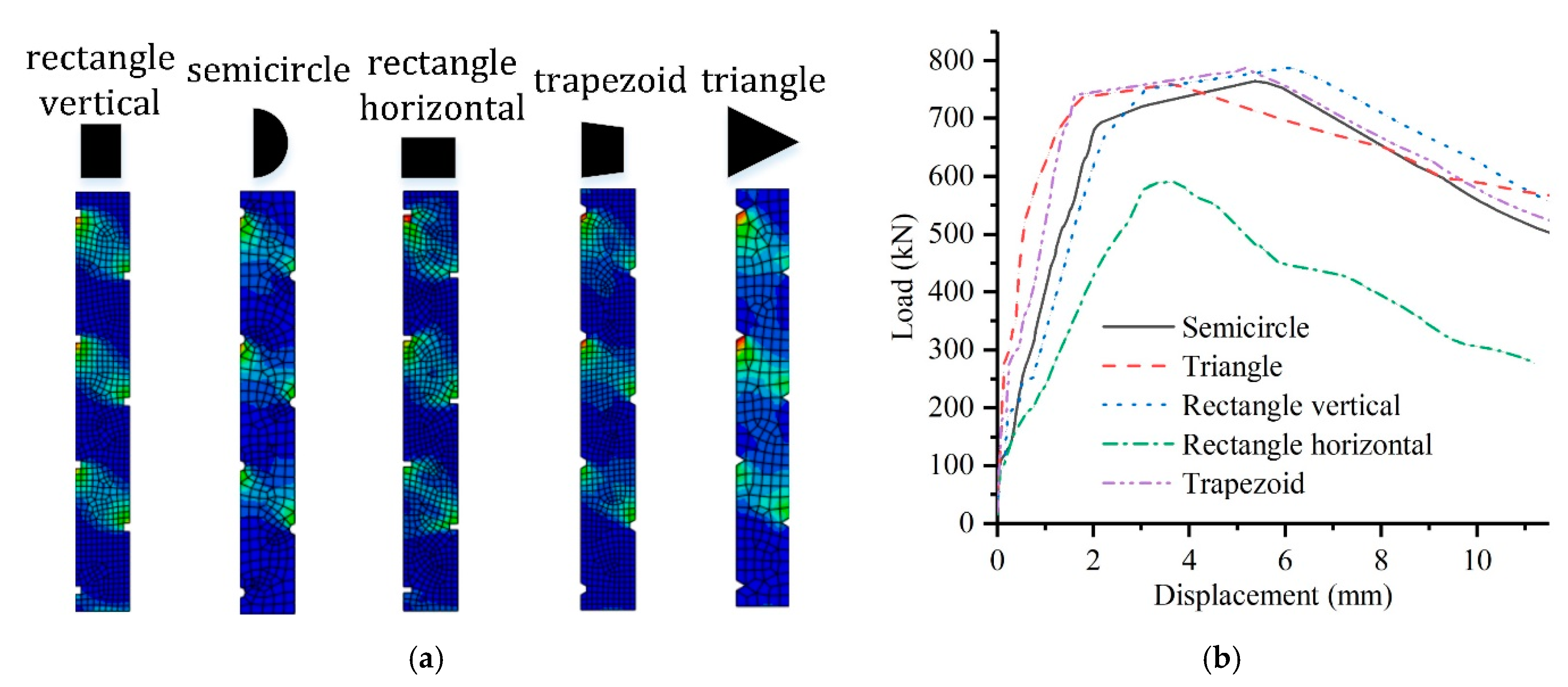
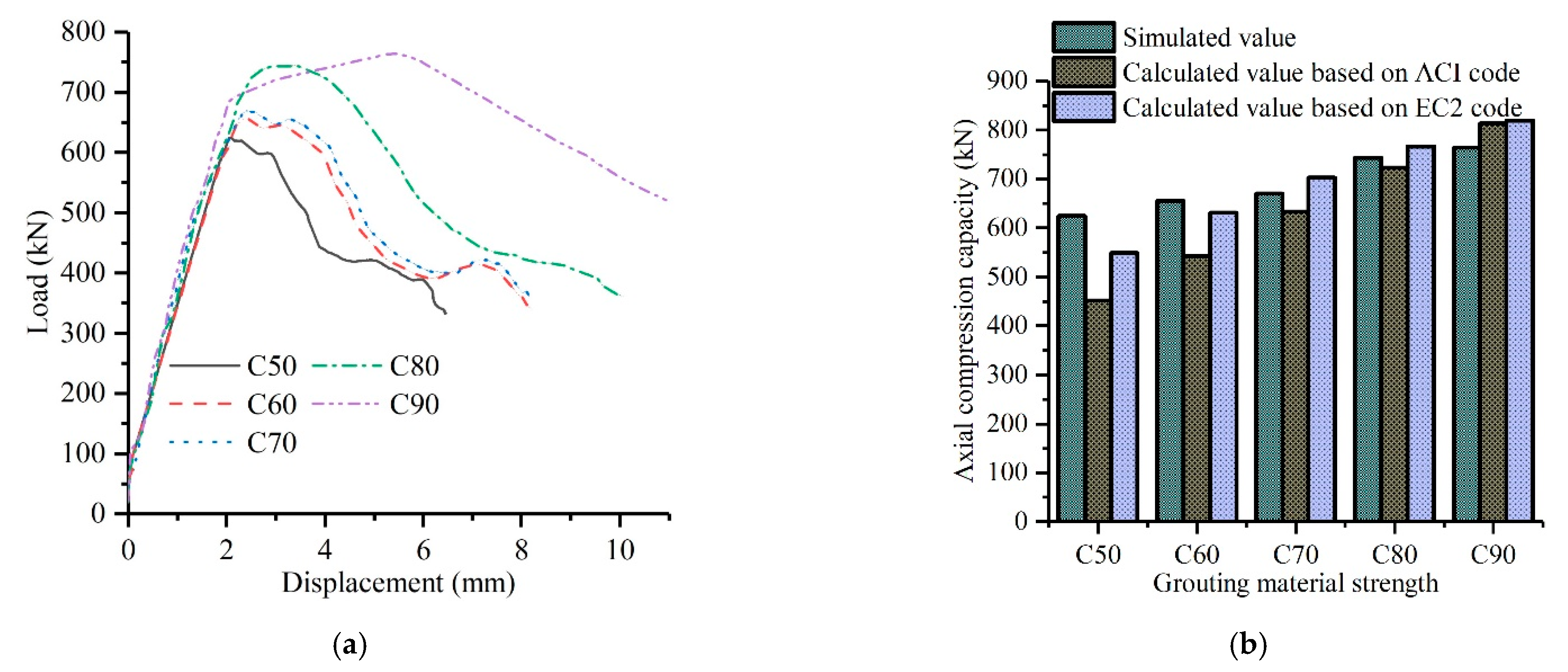
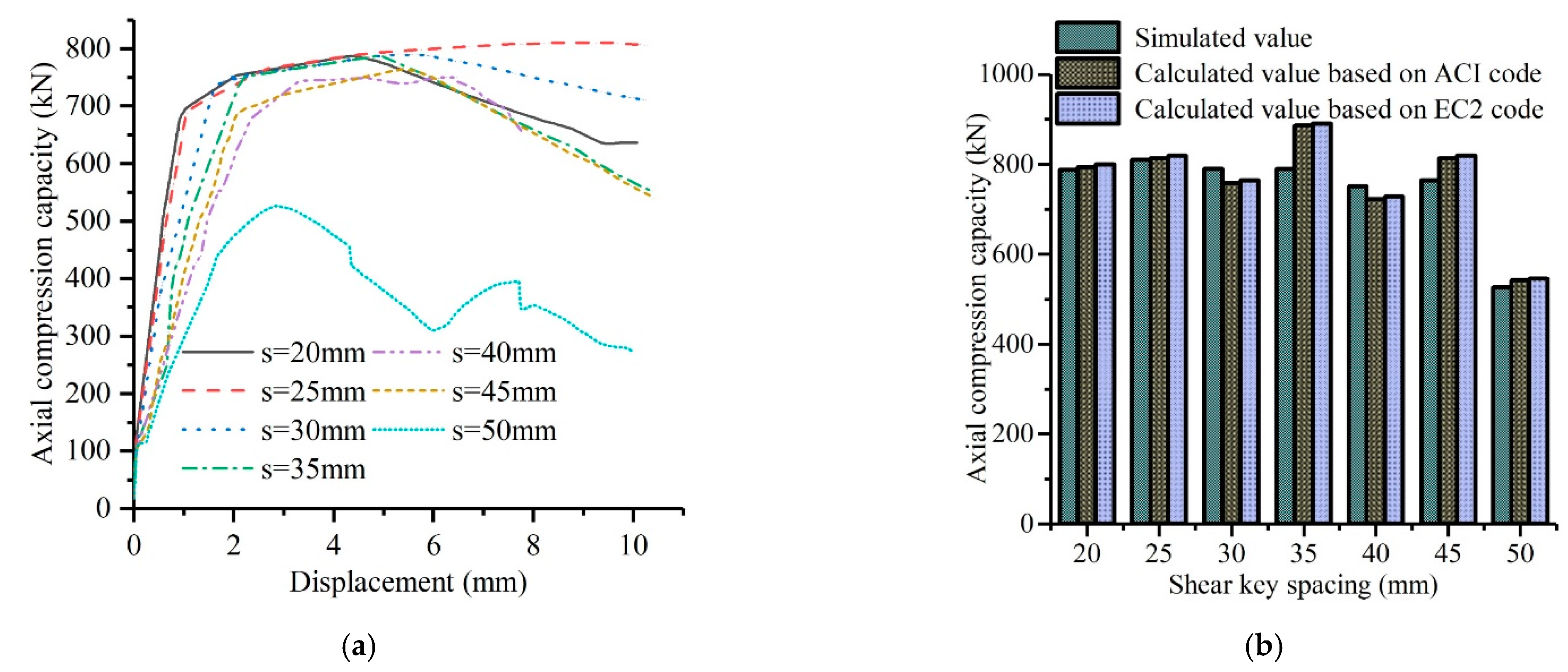
| Specimen | Dg/mm | L/mm | s/mm | h/mm | Pu/kN |
|---|---|---|---|---|---|
| 60a | 102 | 60 | 19 | 2.5 | 487.5 |
| 60b | 102 | 60 | 19 | 2.5 | 638.4 |
| 60c | 102 | 60 | 19 | 2.5 | 436.8 |
| 80a | 102 | 80 | 19 | 2.5 | 713.1 |
| 80b | 102 | 80 | 19 | 2.5 | 765.0 |
| 80c | 102 | 80 | 19 | 2.5 | 680.8 |
| 100a | 102 | 100 | 19 | 2.5 | 863.3 |
| 100b | 102 | 100 | 19 | 2.5 | 884.5 |
| 100c | 102 | 100 | 19 | 2.5 | 779.1 |
| A1 | 60.3 | 150 | 35 | 2 | 517.3 |
| A2 | 60.3 | 150 | 40 | 2 | 532.0 |
| A3 | 60.3 | 150 | 45 | 2 | 566.7 |
| A4 | 60.3 | 150 | 35 | 1 | 455.1 |
| A5 | 60.3 | 150 | 40 | 1 | 514.7 |
| A6 | 60.3 | 150 | 45 | 1 | 499.1 |
| B1 | 88.9 | 150 | 35 | 2 | 757.2 |
| B2 | 88.9 | 150 | 40 | 2 | 779.8 |
| B3 | 88.9 | 150 | 45 | 2 | 799.5 |
| B4 | 88.9 | 150 | 35 | 1 | 747.4 |
| B5 | 88.9 | 150 | 40 | 1 | 693.3 |
| B6 | 88.9 | 150 | 45 | 1 | 662.1 |
| C1 | 114.3 | 150 | 35 | 2 | 912.5 |
| C2 | 114.3 | 150 | 40 | 2 | 878.5 |
| C3 | 114.3 | 150 | 45 | 2 | 925.0 |
| C4 | 114.3 | 150 | 35 | 1 | 912.4 |
| C5 | 114.3 | 150 | 40 | 1 | 741.0 |
| C6 | 114.3 | 150 | 45 | 1 | 583.0 |
| D1 | 139.7 | 150 | 35 | 2 | 869.9 |
| D2 | 139.7 | 150 | 40 | 2 | 1050.8 |
| D3 | 139.7 | 150 | 45 | 2 | 1021.6 |
| D4 | 139.7 | 150 | 35 | 1 | 993.1 |
| D5 | 139.7 | 150 | 40 | 1 | 923.0 |
| D6 | 139.7 | 150 | 45 | 1 | 805.0 |
| Specimen | Calculated/Experimental | Specimen | Calculated/Experimental |
|---|---|---|---|
| UC60a | 0.79 | B3 | 1.02 |
| UC60b | 0.71 | B4 | 1.17 |
| UC60c | 0.78 | B5 | 1.03 |
| UC80a | 0.72 | B6 | 1.21 |
| UC80b | 0.79 | C1 | 1.24 |
| UC80c | 0.66 | C2 | 1.05 |
| UC100a | 0.74 | C3 | 1.12 |
| UC100b | 0.85 | C4 | 1.23 |
| UC100c | 0.73 | C5 | 1.24 |
| A1 | 1.17 | C6 | 1.77 |
| A2 | 0.93 | D1 | 1.59 |
| A3 | 0.98 | D2 | 1.07 |
| A4 | 1.31 | D3 | 1.24 |
| A5 | 0.95 | D4 | 1.38 |
| A6 | 1.10 | D5 | 1.21 |
| B1 | 1.17 | D6 | 1.56 |
| B2 | 0.93 | - | - |
| Specimen | Calculated/Experimental | Specimen | Calculated/Experimental |
|---|---|---|---|
| UC60a | 0.82 | B3 | 1.02 |
| UC60b | 0.73 | B4 | 1.16 |
| UC60c | 0.81 | B5 | 1.04 |
| UC80a | 0.75 | B6 | 1.22 |
| UC80b | 0.81 | C1 | 1.23 |
| UC80c | 0.69 | C2 | 1.06 |
| UC100a | 0.78 | C3 | 1.13 |
| UC100b | 0.87 | C4 | 1.23 |
| UC100c | 0.76 | C5 | 1.25 |
| A1 | 1.17 | C6 | 1.78 |
| A2 | 0.94 | D1 | 1.58 |
| A3 | 0.99 | D2 | 1.08 |
| A4 | 1.30 | D3 | 1.25 |
| A5 | 0.95 | D4 | 1.37 |
| A6 | 1.11 | D5 | 1.22 |
| B1 | 1.16 | D6 | 1.57 |
| B2 | 0.93 | - | - |
Publisher’s Note: MDPI stays neutral with regard to jurisdictional claims in published maps and institutional affiliations. |
© 2022 by the authors. Licensee MDPI, Basel, Switzerland. This article is an open access article distributed under the terms and conditions of the Creative Commons Attribution (CC BY) license (https://creativecommons.org/licenses/by/4.0/).
Share and Cite
Che, W.; Chen, J.; Cao, J.; Tian, W. Strut-and-Tie Model and Numerical Simulation of Sleeve Grouting Connection for Concrete-Filled Steel Tube Column. J. Mar. Sci. Eng. 2022, 10, 629. https://doi.org/10.3390/jmse10050629
Che W, Chen J, Cao J, Tian W. Strut-and-Tie Model and Numerical Simulation of Sleeve Grouting Connection for Concrete-Filled Steel Tube Column. Journal of Marine Science and Engineering. 2022; 10(5):629. https://doi.org/10.3390/jmse10050629
Chicago/Turabian StyleChe, Wenpeng, Jianwei Chen, Jinglu Cao, and Wenling Tian. 2022. "Strut-and-Tie Model and Numerical Simulation of Sleeve Grouting Connection for Concrete-Filled Steel Tube Column" Journal of Marine Science and Engineering 10, no. 5: 629. https://doi.org/10.3390/jmse10050629
APA StyleChe, W., Chen, J., Cao, J., & Tian, W. (2022). Strut-and-Tie Model and Numerical Simulation of Sleeve Grouting Connection for Concrete-Filled Steel Tube Column. Journal of Marine Science and Engineering, 10(5), 629. https://doi.org/10.3390/jmse10050629





